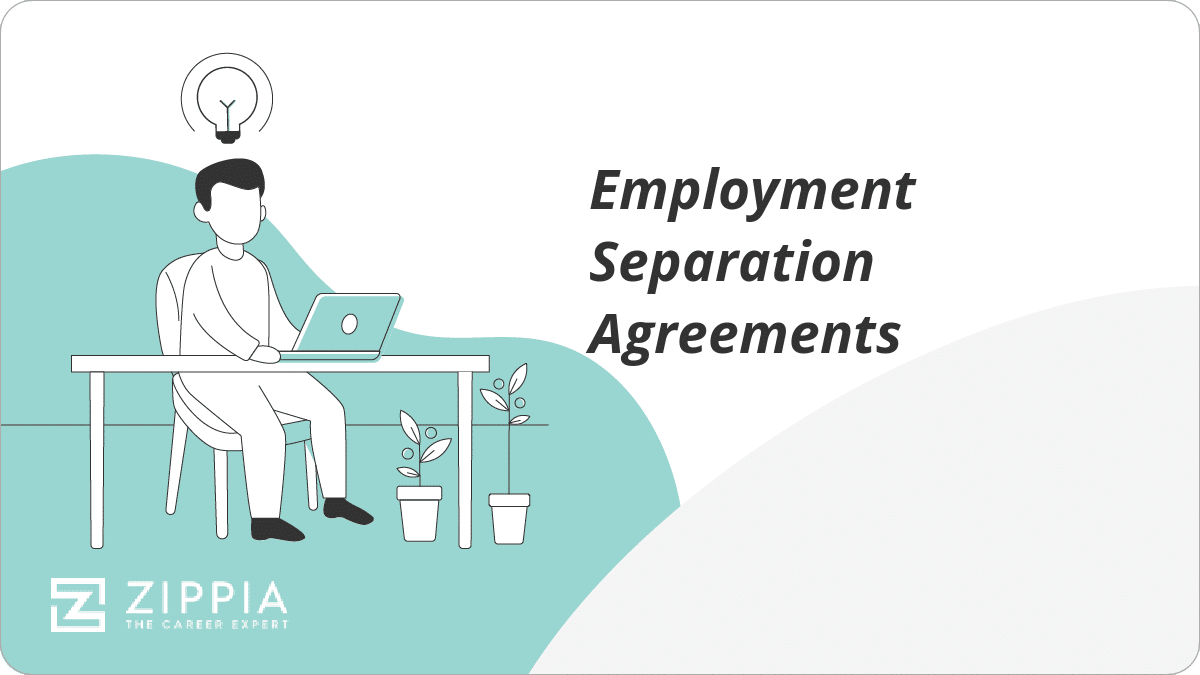Find a Job You Really Want In
When a company decides to terminate a position, they will likely want the employee to sign a separation agreement. This document outlines the terms of the employee’s termination in a way that hopefully ends up being a win-win for employer and employee. Think of it as a formal way of stating that both parties view the termination as fair.
Separation agreements can also be called “termination agreements,” “release of employment claims,” and “severance agreements.” By any name, this document is not required by law, but a company will employ its use when they want to keep company information confidential or protect themselves from potential legal troubles down the road.
Key Takeaways:
-
An employee separation agreement is a legal document that lays out an understanding between a company and a terminated employee.
-
A separation agreement usually covers:
-
Separation details
-
Severance details
-
Confidentiality clause
-
Age discrimination reference
-
-
Before signing any separation agreement, make sure you understand exactly what rights you are giving up and what the agreement entails.

What Is a Separation Agreement?
An employee separation agreement is a legal document that lays out an understanding between a company and a terminated employee.
-
After both parties sign, the terminated employee gives up their right to take legal action against the company in the future (i.e., suing for wrongful termination or severance pay). The conditions agreed to will supersede any other agreements between the two parties.
-
Most employment in the U.S. is “at-will,” meaning that an employer can fire any employees at any time and for no reason. Of course, a discriminatory motive for firing an employee, based on race, sex, age, ethnicity, disability, pregnancy, religion, etc., would be against the law, and cannot be used as a reason to terminate an employee.
-
Ultimately, separation agreements exist to protect companies from litigation from former employees, so you may wonder what’s in it for the workers. Usually, in exchange for “waiving their claims” (as in, surrendering your right to sue in the future), workers receive some sort of compensation, in the form of benefits or cash.
What Does a Separation Agreement Cover
Employment separation agreements can vary considerably in content. That being said, some provisions are usually included:
-
Separation details. An employment separation agreement should lay out some basic terms, such as identifying both parties (company and terminated employee), the final date of employment, and possibly a reason (termination, layoff, resignation, etc.).
-
Waiver of claims. Every employment separation agreement will include language that stipulates the employee is waiving claims they can bring against their former employer. Essentially, this means that a terminated employee can no longer bring a lawsuit against their former company.
This may include the terminated employee waiving their right to pursue a wrongful termination or compensation claim against the company. Read the language of your specific contract carefully, because the exact lawsuits a terminated employee is refrained from filing depends on the wording of the document.
-
Severance. This is the carrot that a company uses to incentivize a soon-to-be former employee to sign the contract. A severance package can include a collection of benefits, possibly including additional payments, continued health insurance for a time, or stock options.
Note that severance is optional and that the law only stipulates that an employer pays wages due to the final working day and any leftover vacation time.
Before entering into negotiations, study up on your company’s policy regarding severance to make sure you’re receiving everything you’re entitled to. To reiterate, a separation agreement trumps all other contracts signed with the company, including an employment contract.
The agreement should clarify the exact amount of compensation the former employee will receive, the nature of that compensation, the method for delivering that compensation, and the exact timeline that the employee will receive those benefits.
-
General fee. Distinct from a severance package, a company may offer employee money to sign the agreement. This is not a very common practice.
-
Non-compete clause. If you’ve already signed a non-compete clause at the start of or during your employment, this probably won’t show up here as it would be redundant. A non-compete clause basically states that you may not enter into a position that puts you in direct competition with your former employer.
-
Confidentiality clause. Depending on the nature of your work, a confidentiality clause may appear in your separation agreement. This prohibits the former employee from sharing company secrets with outsiders, protecting the company’s intellectual property.
-
Non-disclosure clause. Similar to a confidentiality clause, but relating to the employment separation agreement itself. You may not be allowed to share the details of your agreement with anyone.
-
Non-disparagement clause. An employment separation agreement may include language prohibiting the former employee from publicly disparaging his or her former company.
-
Age discrimination reference. If an employee is over the age of 40, they are protected by the Older Workers Benefit Protection Act (OWBPA) which is a part of the Age Discrimination in Employment Act (ADEA).
Why Use a Separation Agreement?
Employment separation agreements exist primarily to protect the interests of a company.
-
An employee isn’t forced to sign an agreement and therefore has some leverage to make sure his or her rights are also being protected. Make sure you understand exactly what rights you are giving up and that waiving these rights is worth whatever the agreement offers.
For example, if you truly feel that you were wrongfully terminated, based on discrimination, you should consider seeking an alternative route to make sure your rights are protected and eschew signing the agreement.
-
You should also think carefully about what the agreement covers. Pay attention to the time frame laid out in the agreement and understand what period of time it covers (i.e., up until the day of your termination or class action lawsuits way down the road).
-
It’s important that you don’t feel bullied into signing an overly-complicated document that you don’t fully understand the implications of. If the jargon is too much to wrap your head around (by design), seek legal counsel. You should never waive your rights if you are confused as to what exactly you are giving up. Make sure your interests are protected, not just your former company’s.
Extra Separation Agreement Information for Employees Over 40
As mentioned above, termination based on discrimination of any kind is grounds for a wrongful termination lawsuit. This includes employees over the age of 40, who are protected by the Older Workers Benefit Protection Act (OWBPA), a part of the Age Discrimination in Employment Act (ADEA).
The OWBPA protects workers over the age of 40 from age discrimination and sets strict terms that employers must adhere to when terminating older employees. Note that all separation agreements for employees over 40 must specifically refer to the ADEA. If the employer fails to reference the ADEA, the former employee would have grounds to pursue a lawsuit.
Additionally, special rules apply to employees over 40. Such employees have 21 days to consider the severance offer before it expires. After signing, an employee over 40 also has 7 days to revoke the agreement.
Questions to Ask Yourself About Your Separation Agreement
At the end of the day, a good separation agreement exists to protect both the company’s interests and your own. Be wary of employers who draft intensely jargon-y and complicated separation agreements, as this may be a tactic to intimidate you into signing onto something that you don’t fully understand. If your company tries to pull this, seek legal counsel before signing anything.
Other things to consider inlcude:
-
What claims will you be giving up? Make sure you fully understand the terms of any non-compete, non-disclosure, non-disparagement, or any other restrictive clauses in your contract. If you don’t, ask questions of the HR team and whoever else is representing your company. If their answers aren’t clear or make you feel uncomfortable, seek legal counsel.
-
Is the reason for your termination made explicit? If you feel you’re being wrongfully terminated for something discriminatory, don’t sign a separation agreement. The language of the contract should make it clear why you’re being terminated and you should feel comfortable agreeing with that reasoning before you sign it.
-
What range of time does your separation agreement cover? If the language of the contract stops you from certain behaviors in the future, be aware that it is far more restrictive than a contract that only covers a time frame limited to your time of employment.
-
How are my rights protected by this contract? A contract should always serve both parties — if you feel like you’re getting the raw end of the deal, don’t sign the contract until you can renegotiate the terms or speak to a labor lawyer.





